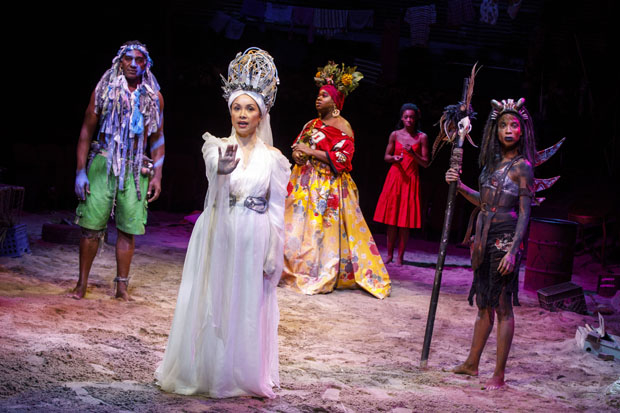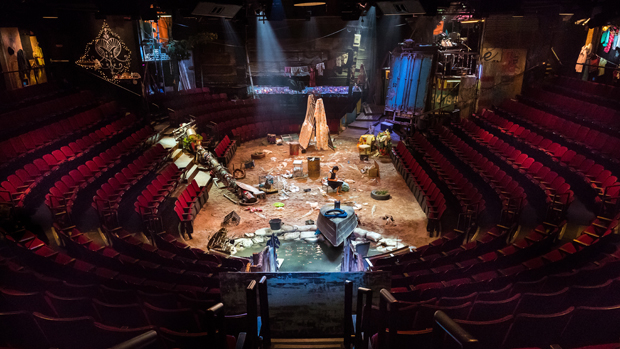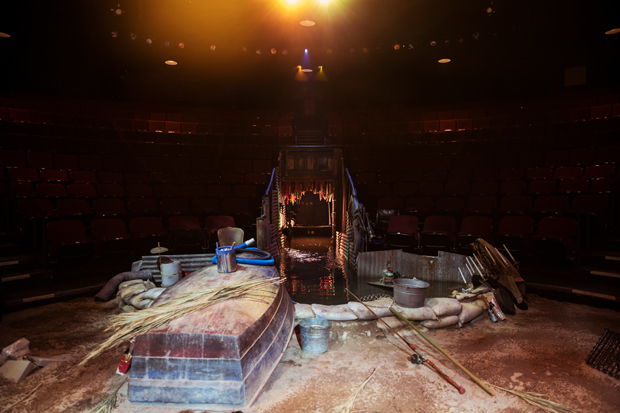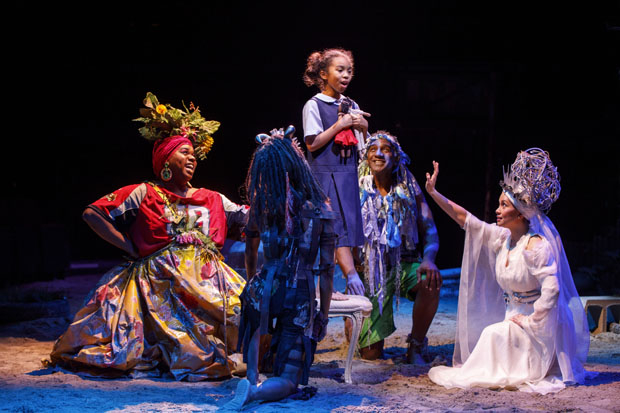How Broadway's Once on This Island Was Designed at the Mercy of Mother Nature

(© Joan Marcus)
In the field of three musical revivals on Broadway this season, one of these things is very much not like the others. Up at Lincoln Center's Vivian Beaumont Theater, Lauren Ambrose has a luxurious two-story mansion to dance all night in as My Fair Lady's Eliza Doolittle. Down at the Imperial Theatre, Carousel's complicated love story is set against both a sparkling seascape and a heavenly forest of stars. And then you have Once on This Island, a show that is, quite literally, a disaster area. Lynn Ahrens and Stephen Flaherty's 28-year-old property is getting its hands, feet, and every other body part dirty in the pit of sand that now constitutes the in-the-round stage at Circle in the Square Theatre. It's the farthest thing from the pristine trappings of the delicate Broadway classics by Lerner and Loewe, and Rodgers and Hammerstein, but for scenic designer Dane Laffrey, messy was the only way to go.
"We're talking about a group of people at the mercy of the wind and the rain," says Laffrey from a seat in an empty preshow house. "It felt so natural that we would just allow the piece to sort of exist in an honest space."
These people at the mercy of the elements are the citizens of Haiti — the hurricane and earthquake-ravaged island nation where Michael Arden's production of Once on This Island is located (the novel My Love, My Love; or, The Peasant Girl on which the musical is based is nebulously set somewhere in the Caribbean). An overturned boat, a pool of flood water, and a jackknifed 18-wheeler carrying relief parcels filled with macaroni and cheese are a few of the set pieces that settle us into a post-disaster environment.

(© Andrew Kluger)
The shadow of that aesthetic was the starting point for Laffrey and Arden, a pair of collaborators who had already worked together on Arden's 2015 revival of Spring Awakening (Laffrey's Broadway debut) and who began their creative mind meld 20 years ago as friends and senior roommates at Interlochen Arts Academy (Arden was an actor, while Laffrey, even then, was set on design). By a music workshop in December 2016, Laffrey already had a set model with several elements that made it into the final design (including the theater itself, which he dreamed into reality by presumptuously designing his early model around Circle in the Square, though they had not yet acquired the venue).
Time passed, producer Ken Davenport landed them their dream theater, and the creative team was working against real Broadway deadlines, when a work trip to Port-au-Prince forced Laffrey to pump the brakes.
"That trip sort of upended our process a little bit," he said. Was it back to square one? "No — but kind of."
"It had this incredible density. The photos don't exactly capture what that is," said Laffrey, attempting to verbalize his immediate impressions. "I guess we were expecting to see the evidence of natural disasters — the years of political corruption, incredible poverty, and a lack of infrastructure. And that's there. But the thing we couldn't have known until we were on the ground was how much resilience is present. It really informed the design."
The flood waters got to stay, as did the beat-up truck ("I do have a bit of a love affair with that truck," Laffrey confessed) — though instead of being the center of a large installation at the end of the stage, it now inconspicuously pokes out of the corner as if it just drove through the theater's wall.

(© Andrew Kluger)

(© Andrew Kluger)
The change may sound subtle, but for Laffrey, it helped transform the spirit of the room to one more in keeping with what he and Arden experienced in Haiti. "It was sort of wallowing in a sense of destruction, as though something had just befallen this theater," he said, describing his early designs. "We got away from there and thought, 'That's not quite it. The country doesn't feel victimized. It feels vibrant and amazing.' I think we had sort of misunderstood that."
Rather than a feeling of "What do we do?", as Laffrey described it, the space began to convey a feeling of "Life goes on."
And in Once on This Island life does go on — through the art of storytelling. "The Sad Tale of the Beauxhommes" is performed as a theatrical origin story of an island divided by hate and racial prejudice, while the Romeo and Juliet love story of peasant girl Ti Moune and the wealthy Daniel Beauxhomme becomes an immortal fable about the power of love. "We needed to lean into this primal aspect of people receiving story in a circle," said Laffrey. "Being down there in the sand and sharing that space with the audience feels like a powerful thing."

(© Joan Marcus)
Of course, such a "primal" design filled with natural elements like sand brings challenges of its own. "It's temperamental," Laffrey joked. "It has to be disinfected, the sand gets tracked out and has to be replaced — plus there are goats," (a pair of Broadway stars named Sparky and Peapod who periodically join the cast onstage). "It's kind of like a living thing, which is good and bad."
Good: The stage requires no drainage despite the 30-second monsoon that happens in the middle of the show each night. "The sand actually absorbs it and just wicks it away — which is kind of amazing because that would have been impossible."
Bad: "It gets really dusty," he said, just as a man down on the sand pulled out a hose to do what has evolved from a watering-can dampening to a full preshow soaking. "We discovered that on the second day of tech. That was a dangerous day," he laughed.
"It's challenging for the actors," Laffrey admitted, "but I think if you actually ask them in a serious moment when we're really talking about the beating heart of the piece, I don't think you do it another way. It's not illusory. It's real. You inhabit it, and it conjures whatever it conjures — and not because we're tricking you. All of that feels central to my practice and what I want to make across my body of work."

(© Andrew Kluger)











